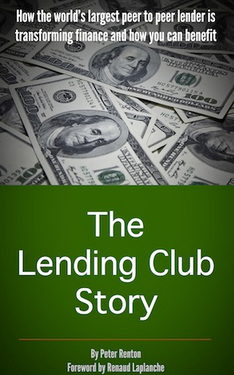Peter Renton releases The Lending Club Story.
Over the weekend, I sat down with a good book… about peer to peer lending.
The Lending Club Story was penned by Peter Renton, founder of Lendacademy.com , and is one of the first books about crowdlending to hit the shelves and – to the best of my knowledge – the first and only one focusing on the Lending Club story.
Lending Club, as one of the big US P2P Lenders, is a slightly different kettle of fish to FundingKnight or other P2P or P2B Lenders here in the UK (for starters P2P is already regulated in the US…) but despite the differences, it’s an interesting read for UK P2P enthusiasts.
You can Click here to read Peter Renton’s own introduction to his book on www.lendacademy.com including an introductory offer for those exceptionally quick off the mark.
There is a huge amount of detail on lending and borrowing via Lending Club which would be highly useful for US based readers but, for me, the best bit was the description of Lending Club’s journey from tiny start-up to an almost profitable business showing phenomenal growth and jointly leading the US into P2P Finance.
There’s also an interesting foreword from Renaud Laplanche, CEO and founder of Lending Club, in which he shares his motivation for setting up the business:
“I realized how the financial system had become focused on itself rather than its customers, and how consumer lending could be made so much more efficient and deliver so much more value.”
That’s a rallying call if ever I heard one, and one that seems to have motivated Laplanche effectively thus far; “In the 12 months ending September 30, 2012, the total amount of loans issued by Lending Club was over $540 million. That is more than 150% growth over the preceding 12 months.”
After a slow start and an interruption to let regulation have its say, Lending Club has gone from strength to strength.
What’s interesting for me, as someone watching the development of P2P lending in the UK, is the industry that has built up around the platform. There are a whole wealth of websites devoted to data mining or evaluating loan notes, which is no surprise given some of the case studies that Renton includes to paint portraits of some of Lending Club’s investors:
“Phillip is a very active Lending Club investor. He logs on every day to look at new loans that meet his criteria. He will always sort the available loans by time remaining so he only looks at the new loans that have just been added. He will spend 30 – 60 minutes every day on Lending Club.
He has a portfolio of around $25,000 invested… and he typically invest $25 or $50 per loan.
Phillip has a second account that he uses mainly for investing on the trading platform*. He has an interesting strategy here. He will look for late loans that are for sale on Foliofn that have a deep discount of 90% or more. He will invest in many of these loans with the hope that some of them will come back to current. He has only been doing this for a few months and he realizes this is a gamble so he only has a small amount of money in this account.
Like many investors he has most of his liquid investments in the stock market, some in savings accounts and he even put some money into U-Haul Investors Club. But his Lending Club investment is the one that gets most of his attention and the investment that he enjoys the most.
His goal with his Lending Club account is to keep growing it to where he can make $2,000 a month in interest.”
It’s investors like Phillip which hold the future of P2P finance. It is there involvement and evangelism that will continue to shift funds away from mainstream banking and into alternative finance. According to Laplanche, that’s what will help capital flow more efficiently. Let’s hope he’s right.
*Lending Club’s secondary market

